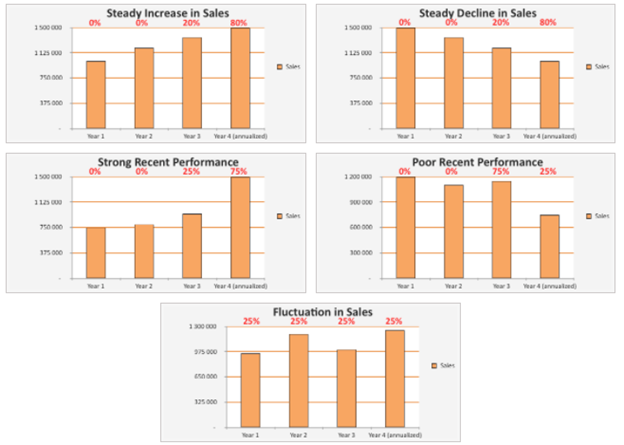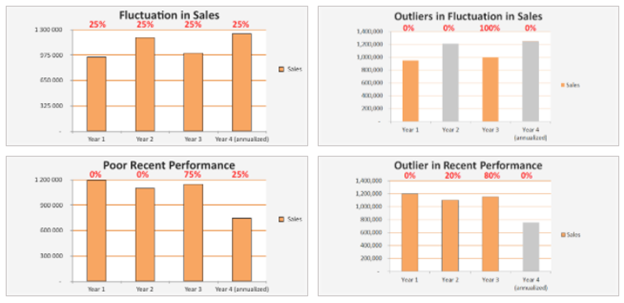15 Oct Valuing a Business is Forward Looking: Using Historical Financials to Shed Light on Future Projections
“What is my company worth?” This seems like such a simple question, but in reality, is quite complex to answer. In today’s world, no two businesses are alike, and even a single business can either have a very consistent trending performance or have fluctuations from year to year. These fluctuations can make determining the fair market value of a business difficult. Therefore, a deeper analysis into a business’s historical financial performance can shed light on future projections and therefore the overall valuation of a business.
Initially, a valuation analyst will look at the company’s EBITDA or seller’s discretionary earnings (SDE). If the company being valued has had recent fluctuations in its sales and/or earnings, the analyst will need to create a weighted historical financials model. Weighted historical financials are calculated by assigning a value, or weight, relative to the importance of each year’s SDE and revenue according to how the company is expected to perform on an average year. More weight is given to years which are better predictors of the company trend and less or no weight is given to years that show atypical business trends. For example, if the company’s revenues were cyclical, with consistent up and down years, each year could be weighted evenly. However, if the company’s revenue was increasing year over year, more weight would be appropriately given to the most recent year(s) of financials, as as these indicate how the hypothetical following year may perform.
The following graphs show how weights (noted as red percentages) might be applied for a few scenarios:

Note: these graphs assume none of these years contain outliers.
Additionally, the company may have certain years which are deemed to be outlier years when applying weight to financials. An outlier year is any year where extraordinary occurrences caused the financials of that year to fluctuate in an unexpected way. For some businesses, historical information is integral to understanding whether certain years are outliers or not. For example, is the fluctuation explained by a temporary change, such as a competitor’s short-term closing for renovations when that competitor is expected to re-open, taking just as much of the market share as before? Or, was the fluctuation due to a more permanent change, such as a change in management, that will be maintained in the coming years? In contrast, some company’s sales may fluctuate according to a predictable pattern year after year, and so long as the financial fluctuation is expected to carry over into following years, then it is not considered an outlier.
A deeper understanding of the historical financials will help determine what is considered an outlier and how financials should then be weighted. The following graphs show how weights may be applied when a company has years that are deemed to be outliers:

By looking at these historical financial models, weighting years as appropriate and determining any historical outliers, a valuation analyst can gain deeper insights into a company’s future projections, and therefore, the overall approach(es) needed to calculate the fair market value of the business.
How has COVID-19 affected how valuation analysts look at historical financials when determining the fair market value of a company?
If a company’s historical financials show a very large fluctuation in its revenues, then using the Market Approach[1] may not make sense to calculate the fair market value of a company. According to the article Business Valuations during the “New Normal”: The Impact of COVID-19:
“Prior to COVID-19, appraisers were able to rely on a Single Period Capitalization method, which is based on the assumption that a company’s historical operations were stable and moreover, a good indicator of stable future performance. Because of COVID-19’s negative expected impact on businesses, appraisers must now rely on the Multi-Period Discounted Cash Flow (DCF) method, which takes into consideration forecasts that go far out enough until a company’s operations stabilize (typically three to five years).” [2]
Therefore, depending on how the subject company was impacted by the COVID-19 pandemic, the valuation analyst may use the Discounted Cash Flow method. When using this method, you will not be asked to assign weight to historical years. The reason for this is that when using the Discounted Cash Flow valuation method, you are assigning 100% weight to the Income Approach[3] and assigning 0% weight to the Market Approach.
[1] Under the Market Approach, a business valuation analyst looks for signs from the real marketplace to figure out what a business is worth.
[2]https://www.linkedin.com/pulse/business-valuations-during-new-normal-impact-covid-19-neal/?trackingId=MBAcuYLRQoSnRLSbWGzC0Q%3D%3D
[3] When reliable market data is hard to find, the business valuation expert may turn to the income approach. This approach converts future expected economic benefits — generally, cash flow — into a present value.

